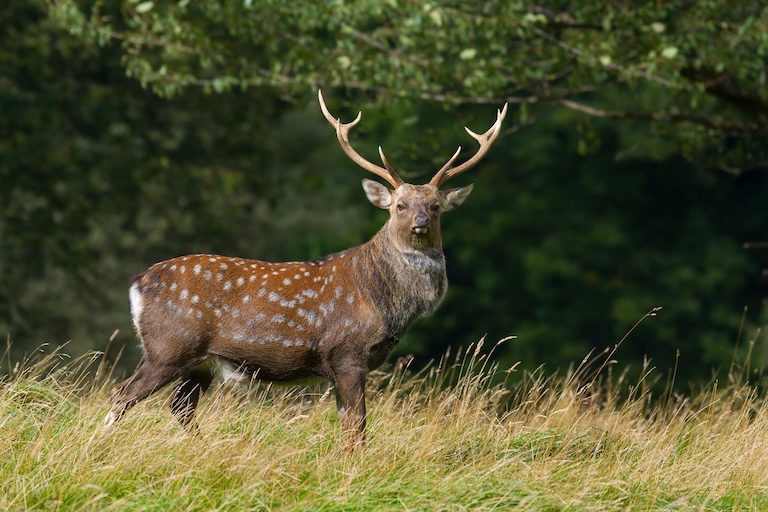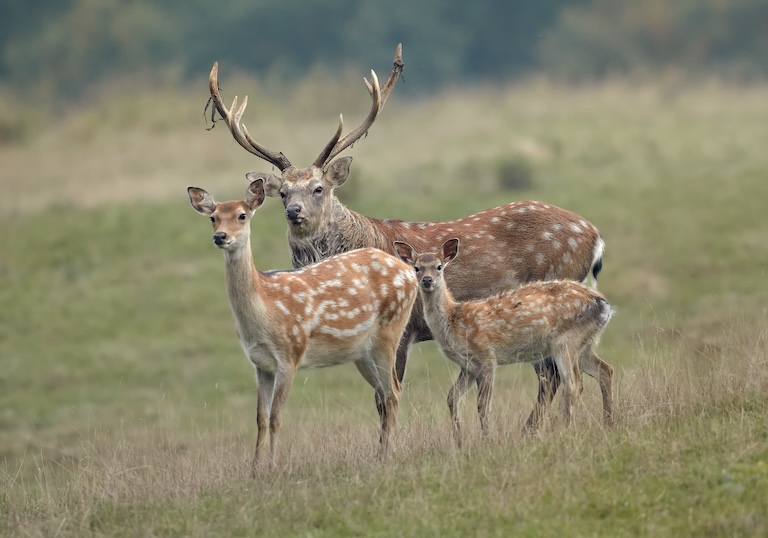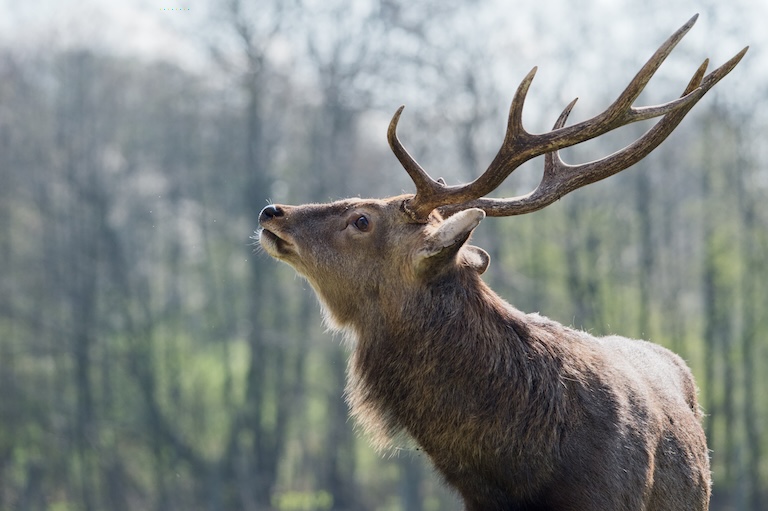Sika Deer Profile
Scotland, they say, has never been conquered.
The Romans, being Italians, couldn’t bring themselves within a hundred miles of a deep-fried Mars bar and had to instead build a wall in order to avoid thinking about it.
And the Scottish cuisine was far too rich and complex for the English to ever overcome. But there is a group of Japanese natives whose invasion was much more insidious and successful than any other recorded attempt.
The Sika deer, a large and handsome animal from Asia moved into the UK sometime around the 1850s and has gradually been inserting its genes into the local populous, having ramped up their presence in Scotland significantly since the 1920s.

Sika Deer Facts Overview
| Habitat: | Typically forests and forest clearings |
| Location: | Eastern Asia, introduced to Europe, New Zealand, and the US |
| Lifespan: | 15 in the wild, 26 in captivity |
| Size: | Largest subspecies is 155 cm (61 in) long, 110 cm (43 in) tall |
| Weight: | Males up to 160 kg (350 lb) |
| Colour: | Fawny/golden brown with white spots |
| Diet: | Marsh vegetation, grasses and agricultural crops |
| Predators: | Tigers, wolves, leopards, and brown bears |
| Top Speed: | Unknown |
| No. of Species: | 1 |
| Conservation Status: | Least Concern |
The Sika is a large and charismatic Asian deer, and a close relative of the European red deer, which is how it’s causing all the trouble in Scotland.
In its home range, it’s part of a relatively stable ecosystem, though it can be a bit of a pest for animal farmers; however, its ability to breed with the red deer and produce viable offspring is wreaking havoc with the red deer’s genetic line in the UK.
Interesting Sika Deer Facts
1. They’re true deer
The even-toed ungulates make up the majority of large mammals we’re familiar with.
This order contains the cow family, deer family, and – just for the sake of shoehorning this in – the Giraffe family, which once contained Sivatherium: a genus of mutant giraffe deer from space with the body of a giraffe and the head of a moose.
Cows and deer aren’t all that different at the family level, as seen in Africa’s most dominant wild bovids: the deer-like antelopes.
But there are some families that get a little confusing, such as the musk deer, which look more like deer but are more closely related to the bovids.
So-called True deer are members of the Cervidae family, and this diverse group is then split into New World and Old-World subfamilies.
Roe, white-tailed, and reindeer are members of the New World subfamily, while the Old-World group contains icons from the petite muntjac to the glorious red deer, Cervus elaphus – one of the closest relatives of the Sika, with whom it shares a genus.

2. They have bred with the red deer
This close relationship has become even closer in many populations in Europe, where Sika deer were artificially introduced via escapes from wildlife parks.
This is perhaps most obvious in Scotland, where the introduced Sika overlaps almost entirely in its range with the native red deer – Scotland’s second-largest wild animal after the Glaswegian.
Being so closely related, the two species have produced hybrids, and there are now only a handful of places that can guarantee purebred red deer populations, including Rum, a small and beautiful island in the Hebrides, where researchers visit to study red deer, unaffected by the Sika’s genetic influence.
Hybrids between the two are fertile, and therefore capable of forming hybrid swarms, which behave and appear in unpredictable ways, potentially causing problems as pests, and certainly threatening the gene pool of the native deer permanently.
Interestingly, Sikas introduced to the US were not able to breed with the native deer there, giving biologists a clue that they were not as closely related as once thought, and in part leading to the removal of the mule deer and white-tailed deer from the Genus Cervus and into their own genus Odocoileus. 1
3. They’re noisy
Deer can make some quite funny noises, especially if you’re not expecting it. Many bark or bellow during mating season, but for the most part, they’re not extremely talkative.
The Sika has a wider vocal repertoire than most and is one of the most vocal of the entire deer family, let alone the Cervus genus.
While males are expected to bellow, or “bugle”, females will also clap back and have a sharp alarm call and mix of soft whistles and bleats when chatting with one another. 2
4. There are a lot of subspecies
Sika deer are originally from Asia, and Japan, along with multiple other islands in the region, are a hotspot for at least two subspecies.
The mainland is home to at least two more subspecies, but the taxonomy gets a bit confusing, especially where hybridisation is present.
It’s likely the Cervus genus as a whole came from around these parts and migrated into Europe from there, and the ancestor of all modern species is thought to have closely resembled the Sika, which would explain the family resemblance between the Asian Sika and the European Red.
Though there are some obvious differences, especially in their fur patterns.
5. They don’t lose their spots
In 1942, Disney’s Bambi taught us that baby deer are adorably spotted orphans who misidentify skunks as flowers.
Some of this is true: new-born and very young deer, fawns, are adorably spotted, and this helps them stay hidden in the dappled light of the forest understory while they are at their most vulnerable.
Mothers will often leave them hidden in a divot while she’s off to forage so as not to draw attention to them with her noisier presence.
But as the fawns age, these spots fade, eventually disappearing for good in almost all species of deer but the Sika.
Sikas keep their spots and it’s possible to identify the subspecies from them. The mainland subspecies have the darkest spots into maturity, while the Japanese and Taiwanese subspecies’ spots are smaller and more faded in the adults.
These spots aren’t as easy to see in the introduced populations on account of their stock being mostly from Japan.
6. They define territories using pee holes
Like the red deer, male Sikas are highly territorial and protect harems of females, often to within an inch of their own lives during mating season.
Males will fight competitors and guard other females by bellowing and rutting and barely having enough time to eat while they do it. They’ll also be carrying around the largest ornamental headdress they can muster, which adds to their energy expenditure and is a symbol of their superior genes.
Territories can be up to five acres and are defined by small scrapes in the earth, filled with pee.
Males need to take heed or face the consequences if they ignore these markers, and fights can be brutal – sometimes leading to death from either wounding or exhaustion of either or both males. 3 4
7. They adapt to hunting pressure
In Japan, the Sika feeds on agricultural crops, and hunters looking for a way of reducing this took to shooting them.
This is a remarkably effective way of stopping a deer from doing anything, but interestingly, it soon became unnecessary. Ttracked deer in the region picked up on this threat and responded by avoiding the farmland entirely, allowing both species to go about their business without conflict.
The idea that a prey species would alter its behaviour in the presence of a predator isn’t a new one – it’s been thoroughly described in the case study of wolf reintroductions to Yellowstone – but understanding exactly how this works could help reduce human-wildlife conflict in areas where the two species overlap.
Deer that were tracked using collars were seen to leave the pasture area just before the onset of hunting season, demonstrating a learned response to the threat of hunting, and suggesting an effective way of training the deer to avoid human resources.

8. They can swim
Hopefully unrelated to the hunting pressure, this species has been witnessed 12 m off the coast of Japan, swimming in the sea.
Whether they were lost or just on holiday, isn’t clear, but this is likely a good way of travelling between islands.
Sika Deer Fact-File Summary
Scientific Classification
| Kingdom: | Animalia |
| Phylum: | Chordata |
| Class: | Mammalia |
| Order: | Artiodactyla |
| Family: | Cervidae |
| Genus: | Cervus |
| Species: | nippon |
Fact Sources & References
- K Abernethy (1994), “The establishment of a hybrid zone between red and sika deer (genus Cervus)”, PubMed.
- “Sika Deer”, MARYLAND DEPARTMENT OF NATURAL RESOURCES WILDLIFE & HERITAGE SERVICE.
- Toshikatsu Kamei (2010), “The Effect of Hunting on the Behavior and Habitat Utilization of Sika Deer (Cervus nippon)”, BioOne Digital Library.
- Toshikatsu Kamei (2010), “The Effect of Hunting on the Behavior and Habitat Utilization of Sika Deer”, Sci Hub.
